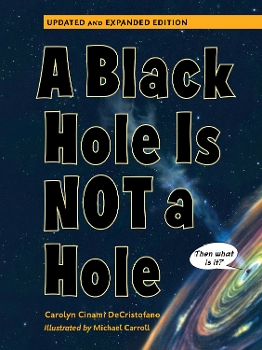Carolyn DeCristofano Brings Humor and Heft to STEM for Kids
A Black Hole is NOT a Hole combines hard science, gorgeous artwork, and great fun

A Black Hole is NOT a Hole combines hard science, gorgeous artwork, and great fun
In this expanded edition of the 2012 original, Carolyn Cinami DeCristofano provides a comprehensive introduction to complex astronomical and scientific questions, including: What is a black hole? How were they discovered? Where do they come from? This new edition brings readers up to date with the latest research and discoveries about black holes. Paintings by Michael Carroll, along with real telescopic images, help readers visualize far- out phenomena like supernovas, bending light, and event horizons.
out phenomena like supernovas, bending light, and event horizons.
Since a black hole isn’t a hole, how would you rename it for clarity?
“A place in space with a powerful pull,” which is from the book, is a good start. “Super-dense matter with light-pulling gravitational power” is more complete, but too clunky. It’s just about as difficult as “completely collapsed gravitational object,” which is one term that was in use before the name “black hole” took off. How about… LEGO, for Light-attracting Extreme Gravitational Object? Or MEGAZ: Most Extreme Gravitational Attraction Zone?
How did you decide to tackle this subject for kids?
The idea came when my editor, Alyssa Mito Pusey, and I were discussing the glossary entry for “black hole” in my prior book, Big Bang! The Tongue-Tickling Tale of a Speck That Became Spectacular. We talked about misconceptions about black holes and that led to me saying, “A black hole is not a hole.” Alyssa chuckled and said I had just come up with the title of my next book.
I soon realized that this would be a great chance to address basic science. So much basic science is packed into black holes: The nature of gravity, density, and light. The scale of the universe and the numbers we use to describe it. There’s also the role of technology in science, as well as how an idea evolves over time.
You first released A Black Hole Is NOT a Hole in 2012. What’s the most important new material in this edition?
By far, the most important new material is the new chapter about scientists’ quest to capture an image of a black hole. Because the basic science behind black holes hasn’t changed all that much, this new chapter adds depth to the story of how science works, and captures a riveting moment in history.
changed all that much, this new chapter adds depth to the story of how science works, and captures a riveting moment in history.
And perhaps most important to me, this new chapter is a chance to emphasize that science relies on diverse communities of people and collaboration.
Black holes are invisible, so what’s the function of the artwork?
The art is absolutely integral. The various artist images are vital to being able to imagine a black hole—the way illustrations help shape our sense of dinosaurs. Whether we are looking at an artist’s conception or a scientifically generated image (see the new chapter!), we are making sense of information in a unique way. Michael Carroll’s gorgeous art and more casual sketches help convey awe and stir the imagination.
Can you say more about the metaphors in A Black Hole Is NOT a Hole?
I found that many young readers were already aware of metaphors used to describe black holes in mass media. These tended to depict black holes as hungry, active monsters, giants, or beasts. One metaphor I considered as a replacement was a tornado, but like monsters, they can drop out of “nowhere” and “get you.” So I switched over to the whirlpool metaphor and loved it. As with a black hole, a whirlpool is not going to suddenly appear and ruin your day.
What’s the relationship between your role as a science/STEM educator and a writer?
Writing is an extension of my role as an educator, but using only words and images to convey abstract ideas—without hands-on, guided experiences—challenged me at first. An editor helped me learn to focus on providing a vicarious experience: What can the reader see, think about, imagine doing, connect to? My greatest reward is knowing I’m helping young people feel sparked, ask questions, make predictions, and laugh.
What kinds of black hole headlines might we be reading in fifty years?
Fifty years is a huge span of time in black hole research! It has been only about fifty years since the first black hole candidates were identified So…in another 50 years? Maybe…“Video Released of the Milky Way’s Giant Black Hole.” (Get your popcorn ready. This may come soon, courtesy of the same team featured in the new chapter of A Black Hole Is NOT a Hole.) Or. . .“New Theory of Everything Describes the Center of a Black Hole.” (Ask a scientist what it’s really like at the center of a black hole, and you will probably get a two-word answer: Nobody knows.)
SPONSORED BY CHARLESBRIDGE

RELATED
The job outlook in 2030: Librarians will be in demand
The job outlook in 2030: Librarians will be in demand
ALREADY A SUBSCRIBER? LOG IN
We are currently offering this content for free. Sign up now to activate your personal profile, where you can save articles for future viewing






Add Comment :-
Be the first reader to comment.
Comment Policy:
Comment should not be empty !!!